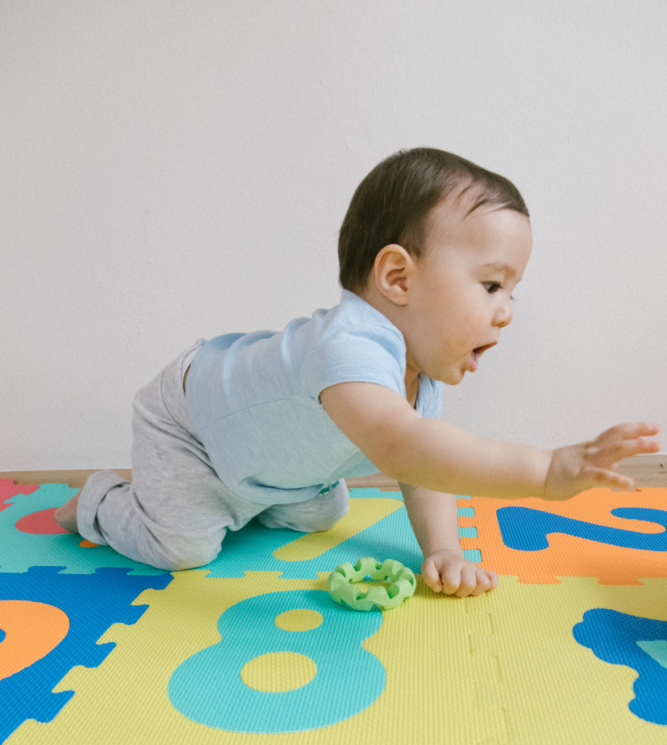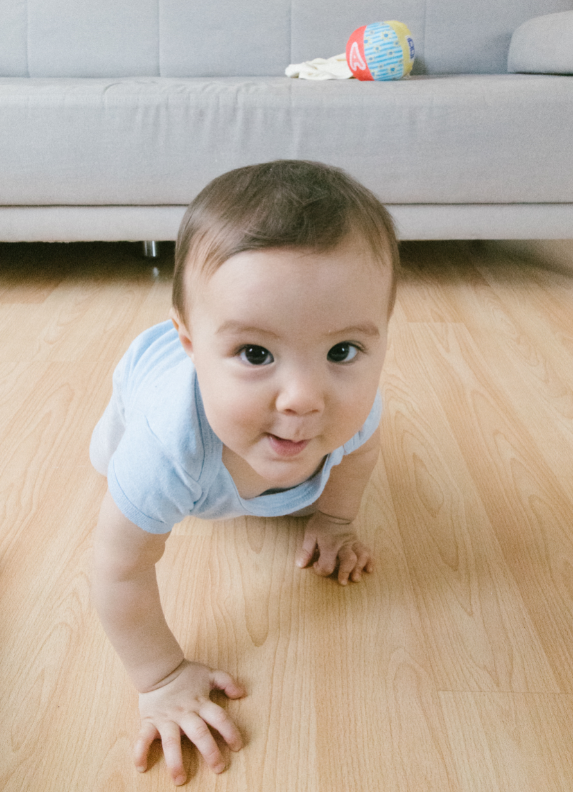Crawling is an important milestone in your baby’s developmental journey. As it is with every milestone, achieving it brings joy and fulfillment. Other important milestones include sitting, standing, and walking. Although developmental milestones are natural and need not be taught, your baby still requires all the support you can provide in this period.
Are you anxiously waiting for your baby to crawl? Have you stopped to consider the part you’ve got to play in your baby’s crawling journey?
If your answer is yes, this is the article for you!
In this post, you’d discover all you need to know about crawling; what it is, the importance, and tips on how to help your baby crawl faster.
First, What Is Crawling?
Crawling is a movement posture your baby displays on his/her developmental transition to walking. On their journey to walking like adults, some babies start by using their arms to pull themselves forward while their legs and stomach remain on the ground. In other instances, some babies use both their hands and knees to get around.

For most babies, crawling starts between the 6th and 10th months of life. However, it is important to remember that the timeline varies for every child.
How Important Is Crawling?
Studies show that motor developmental milestones, like crawling, have a sequential effect on the development of the social and cognitive function in your baby. As your little one begins to crawl, it is expected that he/she would become more interactive, communicative, and better suited to his/her environment.
Crawling is really important because it strengthens your baby’s neck muscles and holds his/her head in an upright position. In addition, crawling strengthens your child’s arms, hands, and fingers for the motor skills needed for a healthy life. Furthermore, this essential motor activity improves the fine control of movements that occurs in your baby’s wrist and knee joints.

Even in older children, the importance of crawling is still evident; especially in developing an overall body posture. In fact, the muscles developed in the crawling phase would help improve your child’s sitting, standing, and walking posture.
Crawling also helps your baby become more aware of his/her spatial position as they develop essential gestures, hold your gaze, and move around the house.
Tips To Help Your Baby Crawl
1. Give your baby adequate ‘tummy time’
Tummy time simply means placing your baby on his tummy.

For your baby to crawl, he/she must develop certain motor skills which depend on increased strength in the muscles of the stomach, neck, arms, back, and shoulders. With the right amount of tummy time, your little one can get this and so much more.
Furthermore, insufficient tummy time exposes your baby to the various risks associated with prolonged lying on the back. These risks include:
- Developing flat spots at the back of the head (positional plagiocephaly)
- Delayed mastering of basic body movements
- Delayed achievement of other motor developmental milestones
Now, here’s a key fact: You don’t need to wait till your baby begins to roll over before introducing tummy time.
In fact, studies show that you can even begin tummy time at birth! It’s simple really, all you need to do is just place his/her head on your chest whenever you can. In addition to helping with the crawling phase, tummy time also provides the skin-to-skin contact needed for proper mother/child bonding and effective breastfeeding.
However, it is important to remember that your child should be placed on his/her back at bedtime to reduce the risk of sudden infant death syndrome. Hence, tummy time is only to be given when your child is fully awake and not alone.
If your baby seems to resist tummy time, by crying or being fussy, you don’t need to worry. Just remember that this is a new experience for him/her and you just have to take it slow.
2. Get on the floor and crawl with your baby
Yes, this works!
Babies find it easy to imitate what they see, so you may want to show your baby how it’s done by crawling with your baby when having tummy time. This really makes it easy for them, especially when you have a baby that loves to imitate everything you do.

In this instance, it helps to have other crawling babies in the family or neighborhood, so your little one can get to be among his/her peers.
3. Move your baby on his/her tummy.
While your baby is having tummy time, gently move your baby forward. As your little one grows, you can also place him/her in a crawling position and support the body weight whilst gently moving his/her hands and knees on the ground.
This affords a measure of safe crawling practice for your growing baby.
4. Help your baby strengthen his/her back.
You need to help your little one develop the strength in his/her back muscles before crawling begins. Now, how do you go about this?
It’s simple, really.
All you have to do is provide support when your baby tries to sit up by holding his/her back and head.
5. Encourage your child to look up
Help your baby practice looking up.
You can do this by dangling a toy in your hand over him/her, this will help strengthen the muscles in the back and neck. You can also hold his/her hand up while playing with him in a standing position. Furthermore, it helps to hold your baby’s gaze while playing to improve concentration.

6. Provide a wide and safe space
Your child needs to feel comfortable enough to crawl. To provide this, you need to ensure that the ground is soft and dry. You can even improve your child’s comfort by placing a blanket on his or her crawling area. Also, it is really important to make sure that this space is free from any sharp or harmful objects that can injure your child.
7. Encourage him/her to reach for objects.
Of course, by this time, your baby would have become really attached to one or more playing objects. You can use this to your (and your baby’s) advantage as he/she learns how to crawl.
All you need to do is just place this object slightly out of his/her reach during playtime. Then sit back and watch your child crawl towards that prized possession. Practicing this a few times every day will help your baby master the skill of crawling to get to where he wants.
However, you shouldn’t practice it too often as it may become boring to your baby.
8. Regulate the use of supportive devices
Keeping the baby on supportive devices such as car seats or strollers for a long time may be detrimental to their strength development. Instead, regulate the use of these devices and encourage him/her to move around, practice effective tummy time, and play with your child as often as you can.
9. Use a mirror
This works beautifully!
Your baby becomes fascinated when he sees himself in front of a mirror so he tries to reach for the mirror to see what’s exactly going on there. Try placing the mirror at a little distance away and make him aware by pointing to it. No doubt, your baby will try to move towards it by crawling all the way to it.
Conclusion
Finally, it is important to remember that babies begin to crawl at different ages. Sometimes, all you have to do is just be patient and support your little one in every way possible.
With the tips in this article, you’re on the right track. Enjoy the journey, Mama!
References
Hewitt L, Kerr E, Stanley RM, Okely AD. Tummy Time and Infant Health Outcomes: A Systematic Review. Pediatrics. 2020 Jun;145(6):e20192168. doi: 10.1542/peds.2019-2168. Epub 2020 May 5. PMID: 32371428.
Yamamoto S, Yonghi L, Matsumura U, Tsurusaki T. Diversity and regularity in infant crawling with typical development. J Phys Ther Sci. 2020;32(8):483-488. doi: 10.1589/jpts.32.483. Epub 2020 Aug 8. PMID: 32884166; PMCID: PMC7443550.

